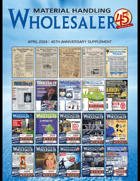 Chris Aiello
Chris Aiello When disasters strike, do you have established vendor relationships to help your company stay operational?
In one of my early editions, I discussed the hidden costs of variability in the supply chain. This is always a relevant topic worth discussing; in that edition, it focuses on shipping delays, raw material shortages, and uncertainty about when your products will arrive.
At the time, you were used to your suppliers providing next-day shipping or local same-day pickup. Weekly stock orders arrive on the same day each week, like clockwork. All of those conveniences we take for granted were unknown variables back then. While we have returned to somewhat normal ‘clockwork’ deliveries, this year has presented its challenges thus far due to weather conditions. Record snowfall and freezing temperatures hampered the start of 2025. Additionally, natural disasters are striking with greater frequency and intensity than ever before.
For material handling dealers, disruptions due to weather or natural disasters don’t just slow things down—they threaten your customer relationships, increase costs, and create uncertainty in an already competitive industry. When parts don’t arrive on time, your customer applications, such as warehouses and distribution centers, can come to a halt, and your customers will quickly seek alternative solutions. The question isn’t whether supply chain disruptions will happen but how prepared your dealership is to handle them when they do.
When disasters strike, dealers’ toughest challenges keep critical parts flowing while navigating supply chain disruptions, shipping delays, and unpredictable customer demands. A single storm or wildfire can shut down a key supplier, leaving dealers scrambling to find alternatives. Freight routes get clogged, labor shortages emerge, and what was once a simple reorder turns into a logistical nightmare. These disruptions lead to longer lead times, higher costs, and customer frustration—things no dealer wants to deal with.
So, what does this mean specifically for smaller forklift dealerships or independent material handling dealers? Unlike large, factory-owned operations, smaller dealers often lack the buying power or extensive supplier networks to absorb shocks easily. Additionally, they may not have the luxury of stockpiling large amounts of parts or the ability to pull inventory from multiple branches. Every disruption hits closer to home—directly affecting the ability to keep their customers’ fleets running.
For example, if your primary supplier’s warehouse is shut down due to a hurricane, your parts orders could be delayed for weeks. That delay doesn’t just impact your inventory; it also disrupts your service technicians’ ability to complete repairs on time. Missed deadlines for preventive maintenance agreements, delayed customer repairs, or repeated back orders will damage your dealership’s reputation and profitability.
These supply chain slowdowns can also create cash flow challenges. You may be required to source higher-cost parts from alternative suppliers or incur expedited shipping fees to meet customer demands. Rising freight costs, combined with unexpected supplier surcharges, erode margins and necessitate challenging pricing decisions. Additionally, with tight inventories, you risk losing parts sales to competitors who can source the part more quickly.
That’s why, if you’re a smaller dealership, you must be intentional about how you prepare. Relying on a single supplier with a single warehouse leaves your business vulnerable. Building relationships with vendors that have multiple distribution centers (Hint, Hint!)—even if they aren’t your primary suppliers—gives you more flexibility when emergencies arise. Having backup plans doesn’t necessarily mean doubling your inventory but having go-to options for high-demand parts.
Another area small dealers often overlook is communication. Customers today expect transparency, especially when their equipment is down. Being upfront about potential delays, explaining why they occur, and offering realistic solutions like substitute parts or service alternatives helps maintain a strong relationship—even when things don’t go perfectly. You might not be able to control the global supply chain, but you can control how you respond.
On the inventory side, even if you don’t have advanced systems, there’s value in closely tracking which parts tend to be bottlenecks during past disruptions. Perhaps it’s hydraulic components, control modules, or specific brands that are more difficult to source when disaster strikes. For example, maintaining a modest buffer stock of these items, especially during peak seasons or hurricane-prone months, can prevent a service shutdown when the next storm arrives.
Technology is another area where small dealers can gain an edge. Cloud-based inventory platforms or vendor portals make it easier to see when suppliers are experiencing slowdowns. You don’t need to invest in expensive systems to benefit—many suppliers now offer real-time visibility tools. Using those tools to react quickly, place orders earlier, and keep your service team informed is key.
Logistics flexibility is crucial, too. You may need to get creative working with local courier services, partnering with other regional dealers to share inventory in a pinch, or shifting to suppliers with distribution centers closer to your market. Having options lined up before disaster strikes helps you avoid last-minute panic.
The truth is that supply chain disruptions aren’t going to disappear. If anything, they’re becoming part of how we do business. That’s why being prepared can’t be something you only think about when things go wrong; it must be part of how you run your business every day. It’s not about fancy tools or overcomplicated strategies. It’s about maintaining a clear line of sight on your inventory, knowing where your parts are sourced, and staying ahead of market changes.
At the end of the day, it comes down to being able to adjust quickly and keep your customers taken care of, even when things don’t go as planned. The dealers who stay flexible, work closely with their suppliers, and communicate openly with their customers will be the ones who remain steady, no matter what’s happening around them.
About the Author:
Chris Aiello is the Business Development Manager at TVH Parts Co. He has been in the equipment business for over 19 years, serving in various roles, including service manager, quality assurance manager, and business development manager. Chris now manages a national outside sales team that sells replacement parts and accessories to various equipment markets, including material handling, equipment rental, and construction and earthmoving dealerships.









